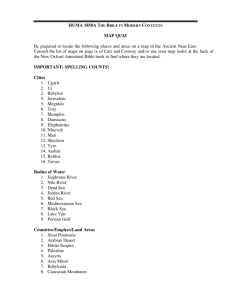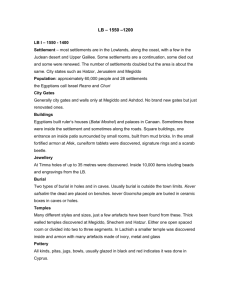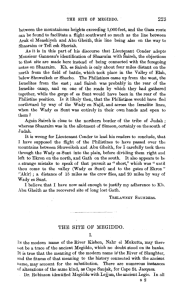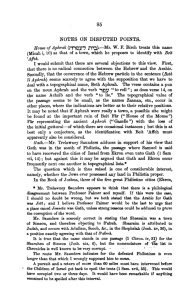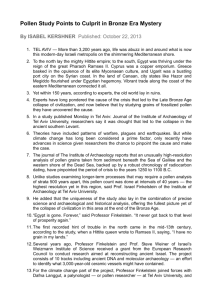The Megiddo Expedition: Archaeology and the Bible ABSTRACT Jennifer Westpfahl
advertisement
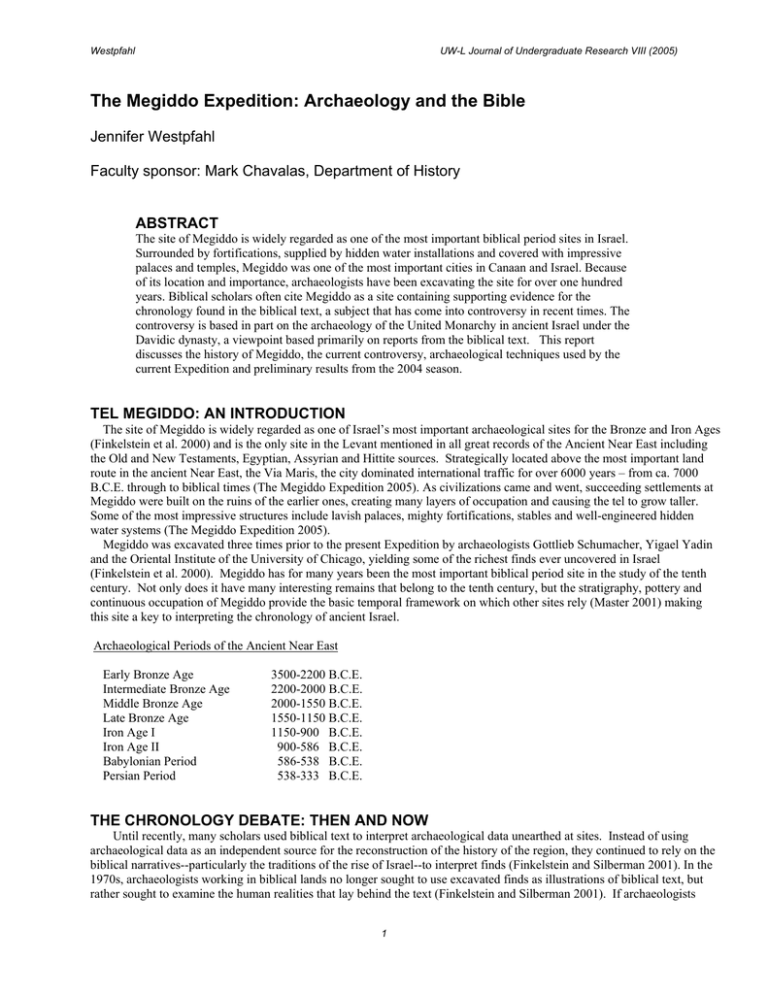
Westpfahl UW-L Journal of Undergraduate Research VIII (2005) The Megiddo Expedition: Archaeology and the Bible Jennifer Westpfahl Faculty sponsor: Mark Chavalas, Department of History ABSTRACT The site of Megiddo is widely regarded as one of the most important biblical period sites in Israel. Surrounded by fortifications, supplied by hidden water installations and covered with impressive palaces and temples, Megiddo was one of the most important cities in Canaan and Israel. Because of its location and importance, archaeologists have been excavating the site for over one hundred years. Biblical scholars often cite Megiddo as a site containing supporting evidence for the chronology found in the biblical text, a subject that has come into controversy in recent times. The controversy is based in part on the archaeology of the United Monarchy in ancient Israel under the Davidic dynasty, a viewpoint based primarily on reports from the biblical text. This report discusses the history of Megiddo, the current controversy, archaeological techniques used by the current Expedition and preliminary results from the 2004 season. TEL MEGIDDO: AN INTRODUCTION The site of Megiddo is widely regarded as one of Israel’s most important archaeological sites for the Bronze and Iron Ages (Finkelstein et al. 2000) and is the only site in the Levant mentioned in all great records of the Ancient Near East including the Old and New Testaments, Egyptian, Assyrian and Hittite sources. Strategically located above the most important land route in the ancient Near East, the Via Maris, the city dominated international traffic for over 6000 years – from ca. 7000 B.C.E. through to biblical times (The Megiddo Expedition 2005). As civilizations came and went, succeeding settlements at Megiddo were built on the ruins of the earlier ones, creating many layers of occupation and causing the tel to grow taller. Some of the most impressive structures include lavish palaces, mighty fortifications, stables and well-engineered hidden water systems (The Megiddo Expedition 2005). Megiddo was excavated three times prior to the present Expedition by archaeologists Gottlieb Schumacher, Yigael Yadin and the Oriental Institute of the University of Chicago, yielding some of the richest finds ever uncovered in Israel (Finkelstein et al. 2000). Megiddo has for many years been the most important biblical period site in the study of the tenth century. Not only does it have many interesting remains that belong to the tenth century, but the stratigraphy, pottery and continuous occupation of Megiddo provide the basic temporal framework on which other sites rely (Master 2001) making this site a key to interpreting the chronology of ancient Israel. Archaeological Periods of the Ancient Near East Early Bronze Age Intermediate Bronze Age Middle Bronze Age Late Bronze Age Iron Age I Iron Age II Babylonian Period Persian Period 3500-2200 B.C.E. 2200-2000 B.C.E. 2000-1550 B.C.E. 1550-1150 B.C.E. 1150-900 B.C.E. 900-586 B.C.E. 586-538 B.C.E. 538-333 B.C.E. THE CHRONOLOGY DEBATE: THEN AND NOW Until recently, many scholars used biblical text to interpret archaeological data unearthed at sites. Instead of using archaeological data as an independent source for the reconstruction of the history of the region, they continued to rely on the biblical narratives--particularly the traditions of the rise of Israel--to interpret finds (Finkelstein and Silberman 2001). In the 1970s, archaeologists working in biblical lands no longer sought to use excavated finds as illustrations of biblical text, but rather sought to examine the human realities that lay behind the text (Finkelstein and Silberman 2001). If archaeologists 1 Westpfahl UW-L Journal of Undergraduate Research VIII (2005) could safely identify relevant strata, we would be able to produce a vivid picture of the material culture and settlement patterns of the tenth century B.C.E. and then identify possible historical nuclei in biblical text (Finkelstein 1996a). This, of course, opened the door for a new debate centered on the chronology of Megiddo. Much of the controversy surrounding Megiddo stems from a debate regarding the strata commonly associated with the United Monarchy, that is, the monarchy associated with King Solomon and David. The site of Megiddo is first attributed to King Solomon in biblical text, and it is this relationship that created bias when scholars interpreted biblical period sites. If we take a look at 1 Kings 9:15 (JPS 1999), we can see just how this can occur: ְדבַר וְזֶה טו-ֲשׁר ֶ ַהמַּס א- ֶה ֱעלָה ַה ֶמּ ֶל ְך ְשׁלֹמֹה, אֶת ִלבְנוֹת-בֵּית יְהוָה וְאֶת-בֵּיתוֹ וְאֶת- ַהמִּלּוֹא, וְאֵת, חוֹמַת ְרוּשׁלִָם ָ וְאֶת ;י-חָצֹר וְאֶת- ְמגִדּוֹ, וְאֶת-גָּזֶר The Hebrew translates, “And this is the account which rose the King, Solomon; to build the house of the Lord and his (own) house; and Millo, and the wall (of) Jerusalem, and Hazor, and Megiddo, and Gezer”. At first glance, identifying the relevant strata of the United Monarchy to the appropriate archaeological site seems to be an easy case (Finkelstein 1996a). Almost all scholars would not hesitate to point to the mid-tenth century strata; the conventional wisdom recognized Stratum VA-IVB at Megiddo, Stratum X at Hazor and Stratum VIII at Gezer as the administrative cities of the period of the United Monarchy (Finkelstein 1996a). The dating of Stratum VA-IVB is at the center of the debate over the archaeology of the tenth century (Master 2001), as scholars have long contended this layer to be the Solomonic City (The Megiddo Expedition 2005). Israel Finkelstein, current director of excavations at Megiddo and professor at Tel Aviv University has proposed a new chronology for the site of Megiddo, known as the Low Chronology Model. Finkelstein and his team have been working at the site for over 10 years. Finkelstein argues that, “much of the tenth century is represented by Stratum VIA. At the time of Stratum VIA Megiddo was a significant settlement with rather impressive buildings. It was annihilated in a terrible conflagration that has become a marker in the stratigraphy of the site. According to the Low Chronology Model, Stratum VA-IVB should be dated to the first half of the ninth century BCE (The Megiddo Expedition 2005)”. Finkelstein’s Low Chronology Model is shown below (figure 1). Figure 1: Low Chronology Model (The Megiddo Expedition 2005) GOALS OF THE MEGIDDO EXPEDITION Beginning in 1992, Israel Finkelstein and David Ussishkin renewed excavations at Tel Megiddo on behalf of the Institute of Archaeology at Tel Aviv University. The scientific and operational framework of the excavation, including the organization of the Expedition’s international consortium was established during the two years preceding the first full-scale season at the site in 1994 (Finkelstein et al. 2000). The Expedition runs under the auspices of Tel Aviv University with Pennsylvania State University as the senior American partner, and is endorsed by the Israel Exploration Society, the National Parks Authority of the State of Israel, the Megiddo Research Council, Kibbutz Megiddo and Lord Allenby of Megiddo (Finkelstein et al. 2000). The aims of the expedition are as follows: (1) The project will stress qualitative rather than quantitative results. 2 Westpfahl UW-L Journal of Undergraduate Research VIII (2005) (2) The Expedition will seek the broadest possible international co-operation and will place special emphasis on an educational program for the students participating in the excavation. (3) In order to clarify the socio-political, economic and demographic relationships between Megiddo and its hinterland, the excavation will be complemented by a survey of the Jezreel Valley. (4) The Expedition will publish final reports on the results of the fieldwork following every two or three seasons of excavation. (5) The Expedition will encourage and assist preservation and restoration work at Tel Megiddo (Finkelstein et al. 2000). The Expedition has renewed investigation in areas previously excavated. It has intended to deal with stratigraphic, chronological, architectural and historical problems that remained unsolved by former excavations in order to decipher the economic, political and social relationship between Megiddo as a royal city and its surrounding countryside. (Finkelstein et al. 2000). THE 2004 EXPEDITION The excavation ran for seven weeks, with an average of 75 people on the Tel, many of them from abroad, and some even sponsored by their universities (the Megiddo Expedition 2005). Team Members stayed at Kibbutz Megiddo, about a fifteen-minute walk from the Tel. Team Members are assigned to a unit within an area of the Tel, allowing them to track their progress throughout the duration of their stay (The Megiddo Expedition 2005). Team Members acted under the supervision of their area supervisor. I was assigned to Area J at Tel Megiddo. Area J, a domestic area, is located inside Area BB of the University of Chicago excavations (Finkelstein et al. 2000). Excavation techniques included loosening soil and stones with a pickaxe, gathering the soil into a bucket and registering any artifacts found. Although there was a ¼” screen available at Area J, the Expedition screened soil only when necessary, unlike archaeology in the Midwest where most soil is screened for artifacts. Once the loose soil was removed and the desired level reached, the walls of the unit were troweled (straightened) and the floor smoothed and brushed. Walls, structures and other stone structures were mapped by the area supervisors and photographed, then removed with a pickaxe to prepare the surface for further excavation. Ceramics found within the floor of the unit required more delicate work with a trowel and brush, exposing the pottery while disturbing it as little as possible. The area was then photographed and documented and the pottery removed. Pottery excavated by Team Members throughout the day was placed in buckets marked by provenience, carried back to the lab area and washed for a period of two hours each afternoon. Team Members inspected each sherd for writing or decoration before washing. If decoration or writing were found, Team Members would gently rinse the piece, inform a supervisor and flag the piece for quick identification. If decoration was not found, Team Members scrubbed pottery with large brushes. Scrubbing was necessary to remove all soil from the sherds, and water was changed often to prevent dirty water from forming a film on the pottery. The pottery was allowed to dry over night and later inspected by Israel Finkelstein and his team for preliminary analysis. During this stage, the Expedition decided which pieces to keep for later analysis. Finkelstein focused most on pottery able to be “typed”. Diagnostic pieces included decorated sherds, rims, bases and unusual pieces; these pieces were kept. Pieces lacking decoration or other diagnostics were tossed, as such pieces were not of any value to the Expedition and would just take up space. Pottery and other artifacts were presumably then entered into the Megiddo Data Management system. The dating of ceramics at Megiddo has played an important role in the controversy surrounding the site. The prevailing view, as reported by The Megiddo Expedition is as follows: “Though lacking dateable anchors, archaeologists sought to identify tenth century BCE strata throughout the country. "Solomonic Megiddo," with its elaborate ashlar (dressed-stone) palaces, and the "Solomonic" four-entry gates at Megiddo, Hazor, and Gezer, long ago became celebrated case studies in biblical archaeology. However, this widely accepted chronological construct is a classic case of circular reasoning. Two theoretical pillars supported the conventional system — one direct and one circumstantial. The former rests on the results of past excavations at Megiddo and the latter on the dating of the Bichrome (that is, decorated in two colors) Philistine pottery” (The Megiddo Expedition 2005). 3 Westpfahl UW-L Journal of Undergraduate Research VIII (2005) The matter regarding the dating of Philistine pottery is quite complex. Finkelstein expresses that, in his opinion, the Bichrome Philistine pottery has been incorrectly dated, and he seeks to “search for the archaeology of the United Monarchy free of any conventional wisdom, text bias, or irrelevant sentimentality (Finkelstein 1996a)”. Pottery analysis now plays a key role during excavations at Megiddo. PRELIMINARY RESULTS The Megiddo Expedition is an ongoing project, and the Expedition excavates at the site only every two years. Archaeology is a slow, methodical process, often taking many years to get a clearer picture of what went on, followed by further planning and excavations. Preliminary results for Area J have been released from the Expedition and are as follows: “In 2000, excavation in Area J exposed the temple hall of the monumental level J-4 (Stratum XVIII) temple, dating to the Early Bronze I (radiocarbon measurements form this building provided calibrated dates in the 31st and 30th centuries B.C.E.). This season, in order to maximal exposure of the ediface we opened six squares to the west of the uncovered portion of the templehall. It was clear form the beginning that a single season would not suffice to reach the floor of the temple-hall. This season was devoted mainly to the exposure of the domestic remains of level J-6 extending above the temple-hall. In two places in the western part of the excavation area we reached brick material of level J-4 at the end of the season. We will probably reach the level of the temple-hall in the next season of excavation (The Megiddo Expedition 2005)”. The Directors of the Expedition have recently decided on the publication of the dig's second final report, which will summarize the results of the seasons of 1998, 2000 and 2002. The report enrolls 39 scholars. The different chapters are scheduled to be submitted to the Directors by November 30th, 2003. The report will be published in 2005 (The Megiddo Expedition 2005). REFERENCES Aharoni, Yohanan 1972 The Stratification of Israelite Megiddo. Journal of Near Eastern Studies 31: 302-311 Finkelstein, Israel 1995 The Date of the Settlement of the Philistines. Tel Aviv 22:213-239. 1996a The Archaeology of the United Monarchy: an Alternative View. Levant 28:177-187. 1996b The Stratigraphy and Chronology of Megiddo and Beth-shan in the 12th-11th Centuries B.C.E. Tel Aviv 23:170-184. Finkelstein, Israel and Neil Asher Silberman 2001 The Bible Unearthed: Archaeology’s New Vision of Ancient Israel and the Origin of its Sacred Texts. Simon and Schuster. New York. Finkelstein, Israel, David Ussishkin and Baruch Halpern 2000 Megiddo III: The 1992-1996 Seasons. Emery and Claire Yass Publications in Archaeology, Tel Aviv University. Tel Aviv. Master, Daniel M. 2001 State Formation Theory and the Kingdom of Ancient Israel. Journal of Near Eastern Studies 60: 117-131. Megiddo Expedition 2005 The 2004 Season. Revelations from Megiddo: The Newsletter of the Megiddo Expedition 9:1-4. Yadin, Yigael 1973 A Note on the Stratigraphy of Israelite Megiddo. Journal of Near Eastern Studies 32:330. 4
